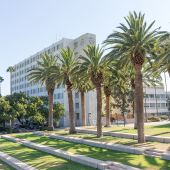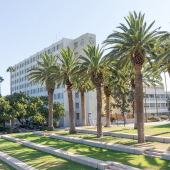Safety is something many education institutions, cities and countries pride themselves on. Their relative safety compared to other more volatile or violent places makes them more attractive places to live and study in, so you will often see institutions celebrating how safe they are.
But how can you quantify safety? What makes one city safer than another? And which are the safest places in which to study?
Awareness, First and Foremost
Firstly, it is important to mention that ‘country safety’ as it will be referred to here, is relative. The majority of countries are safe, especially if you remain aware of any potential danger, and 99.999% of places that offer international education opportunities will be safe- if they weren’t, they would quickly cease to be an education opportunity. The only places you really have to be conscious of are areas that are currently engaged in an ongoing war and even then, many of these conflicts will be contained within particular areas which can often be easily avoided.
It is also worthwhile to note that though it may not always feel like it, Earth is getting steadily, though perhaps a little too slowly, more peaceful. Consistent media reports of crime and violence suggest otherwise, but the media has to be understood as an engine that frequently presents us with the most horrible parts of humanity on any given day.
The vast majority of the planet’s population are capable of great patience and empathy and love, as clichéd as that may sound.
But the ‘feeling’ that the countries of the Earth are getting more peaceful cannot just be left as it is. In our modern world of statistics and measurement and as best as we can get it, objective analysis, an investigation into the safety of a place must be had. That is where groups such as the Institute for Economics and Peace and Economist Intelligence Unit comes in, that form reports such as the Global Peace Index, released yearly, which ranks independent states and territories according to their peacefulness.
Calculating peace or harmony in a country is more complicated than simply adding up all of the crimes that have happened and seeing which country has the fewest. Judging safety is akin to judging the happiness of a place. Though it may seem obvious, it’s very difficult to quantify.
There are 23 indicators used by the Global Peace Index to establish peacefulness:
1. Number and duration of internal conflicts
2. Number of deaths from external organised conflict
3. Number of deaths from internal organised conflict
4. Number, duration and role in external conflicts
5. Intensity of organised internal conflict
6. Relations with neighbouring countries
7. Level of perceived criminality in society
8. Number of refugees and displaced persons as percentage of population
9. Political instability
10. Impact of terrorism
11. Political terror
12. Number of homicides per 100,000 people
13. Level of violent crime
14. Likelihood of violent demonstrations
15. Number of jailed persons per 100,000 people
16. Number of internal security officers and police per 100,000 people
17. Military expenditure as a percentage of GDP
18. Number of armed-services personnel per 100,000
19. Volume of transfers of major conventional weapons as imports per 100,000 people
20. Volume of transfers of major conventional weapons as exports per 100,000 people
21. Financial contribution to UN peacekeeping missions
22. Nuclear and heavy weapons capability
23. Ease of access to small arms and light weapons
In general, these indicators attempt to measure the level of harmony or discord both inside and around a nation, as well as how safe and secure society is in general. Low crime rates, a minimal number of terrorist attacks and violent demonstrations, harmonious relations with nearby countries, stable politics and a low rate of internal displacement, which is to say few people forced to move from their homes for one reason or another.
The Safest Places in the World
It may just be coincidence that the safest countries in the world also happen to offer some of the most unique and delightful study abroad experiences possible, though perhaps not. Here are the top countries, as ranked by a recent Global Peace Index report and how each may be suitable for your study abroad journey.
1. Iceland
Iceland has been ranked as the most peaceful country in the Global Peace Index since 2008.
It is a progressive and peaceful nation that has formed a modern society where freedom and equality are the most important qualities. Iceland continuously ranks near the top of measurements for quality of life, gender equality and democracy, and is one of the highest ranked countries in the world in terms of health care, education and internet availability.
There are seven universities in Iceland. Most of the higher education institutions are run by the state or private parties with state support. Currently there are approximately 18,000 students enrolled in the higher education system, of which about 5% are international students.
2. New Zealand
New Zealand is a beautiful country, that, despite its seemingly small size can feel so huge with its inspiring mountains and wide open country. This space lends New Zealand a patient mood, even in the busiest cities like Wellington, Auckland or Christchurch.
The calm and easy-going nature of New Zealand is representative of the pleasant and welcoming people, as well as the country’s low crime rates and general safety. More so, it has seen a great rise in international students of late, thanks to this safety and the excellent education New Zealand can offer.
3. Portugal
Peaceful and pretty, there is much to love about Europe’s most westerly country. Blessed with beautiful weather, an easy-going people and a charming culture, living in Portugal is like living in a big comfy blanket.
The Portuguese Higher Education system has been undergoing a profound reform of late, in accordance with the European-wide strategy for the modernisation of Higher Education. A series of measures has been introduced in the last few years for the accomplishment of what is known as the Bologna Process, namely with the aim to widen access to Higher Education, guaranteeing quality evaluation and modernising and internationalising Higher Education.
4. Austria
Located in central Europe with some beautiful vistas, Austria also has an excellent higher education system. The significance that Austria places upon higher education is reflected in its tuition fees, which are incredibly low for the standard of education received, even for international students.
The primary language spoken there is German, while English too is popular spoken among residents, making it a great destination to practice multiple languages at the same time.
5. Denmark
Besides its friendly people, safe communities and low crime rate, Denmark is flush with thriving cities and idyllic landscapes. Once you arrive, it can seem obvious just why so many people choose the Nordic nation in which to study abroad. Danish education is innovative and qualifications are recognised worldwide, providing you with an excellent foundation for your future career.
6. Czech Republic
Studying in the Czech Republic places you right in the middle of Europe and gives you a great chance to travel all over the continent and discover countries and places you might otherwise not have the opportunity to visit.
Partly owing to its geographic location, the Czech Republic is situated in the intersection of a great number of cultures. The country's unique cultural blend was historically formed mainly by Slavonic, German, Austrian and Jewish influences, which resulted in a rich Central-European cultural heritage and lifestyle.
7. Slovenia
Though Slovenia has only existed as an independent country since 1991, it already has a rich cultural and educational history. There are courses offered in both English and Slovene at the four main universities: in Maribor, Ljubljana, Nova Gorica and Primorska; with around 50 smaller independent higher education institutions offering numerous study programmes in all other areas.
Much like the Czech Republic and Austria, it is located safely within central Europe, is affordable, pleasant and a testament to the growth the country has gone through in recent years.
8. Canada
Blessed with an almost stereotypically friendly population, Canada is one of the most peaceful countries on the planet. It is beautiful too, with vast stunning landscapes that showcase the exceptional beauty of North America.
It is a modern, progressive nation with open-minded citizens. It has two official languages, English and French and is blessed with a multicultural air. Canadian universities consistently rank among the best in the world, while Canada is consistently rated as one of the best and safest countries in the world to live.
9. Switzerland
While known for academic excellence, Switzerland is also a great place to study if you want to pick up a second language, thanks to the multilingual Swiss population. Depending on where you study you could get to grips with German, French or Italian. Each linguistic area has its own institutions, traditions and cultures, so do your research before you go.
In your study-free hours you'll be able to explore what is widely thought of as one of the most beautiful countries in the world. The Alps dominate 60% of the country but the striking scenery isn't all that's on offer. In the summer you'll be able to enjoy arts and music festivals in Swiss meadows, while in the chillier months you'll have the opportunity to participate in winter sports such as skiing, ice-hockey and skating.
10. Ireland
Ireland is well-known as being home to one of the friendliest populations in the world and in a similar vein makes the top ten safest countries in the world. The Irish Government invests over 782 million annually in research in Ireland's higher education institutions.
Irish universities are in the top 1% of research institutions in the world in terms of research impact in 19 fields, spanning natural sciences, social sciences and the humanities. This creates a unique opportunity for you at undergraduate and postgraduate level to join research programmes that are driving innovation and changing lives worldwide.
11. Japan
Although Japan has had its share of violence in the past, it is now remarkably peaceful and an enormously enjoyable place to study. The Japanese hold community in very high regard, practicing patience and acceptance in all manner of modes of life.
Japan can be a land of contrasts: it can be incredibly busy; Tokyo has over 35 million people living in it, as well as highly technologically advanced, the nation’s infrastructure and innovation has made it the envy of the world in so many ways. Yet a culture and heritage embedded in tranquillity means that you can spend the morning on one of the busiest streets in the world and the afternoon in one of the quietest gardens you will ever come across.
12. Australia
Despite having a population of only 23 million, Australia has the third highest number of international students in the world behind only the United Kingdom and the United States. This isn’t surprising when you consider Australia has seven of the top 100 universities in the world. In fact, with over 22,000 courses across 1,100 institutions, Australia frequently sits above the likes of Germany, the Netherlands and Japan in university rankings lists.
Australia is consistently rated among the happiest countries in the world and has some of the highest ranked cities in the world for student living.
Recognition of the Appeal of Safety
As previously mentioned, by most metrics, almost every country in this day and age can be regarded as safe. But whether you go to a ‘safe’ country or not, you are always going to remain vigilant of your belongings and personal safety. It shouldn’t be something to worry about, but instead be aware of.
You should feel relaxed about your safety, but that is not to say you should be lax in regards to it.
Safety is a key way that governments and universities will encourage a student to study there. Hopefully now you recognise this and bear it in mind when deciding where to go for your study abroad adventure.










